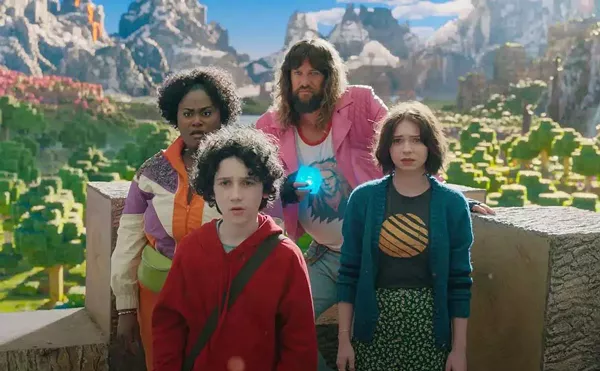Like its subject, Julien Temple's long-awaited doc on the life of one of punk rock's greatest icons is often a contradictory, convoluted mess. If anyone deserves to be the subject of a documentary, it's definitely the co-leader of the Clash. When it was announced that Temple — who did the great Sex Pistols doc The Filth & The Fury and was a close friend of Strummer later in his life — was making this film, most fans assumed it'd be definitive.
The Future is Unwritten, however, suffers from some of the same problems that plagued The Filth & The Fury ... only worse. Fans of Filth will recall how the director would frequently jump to cuts that didn't entirely make sense in context, including numerous shots of Laurence Olivier as Shakespeare's Richard III. That example, though, at least could be unscrambled by the savvy viewer, since Johnny Rotten mentions early in that film that he adapted his Sex Pistols stage persona from Olivier's portrayal of the evil historical figure.
In this film, we get numerous clips from the cartoon version of George Orwell's 1984, as well as the British cult classic, If... — all shown during Strummer's boarding and art school days. Temple's attempting to make a point here, but he never follows through and explains their relevance. Ditto later with scenes from Scorsese's Raging Bull. Thus, all but the savviest Strummer-Clash insiders will be left in the dark.
Even worse, not one talking head here is identified by name or significance. The interviews were shot around a nighttime campfire, mostly in the hills above Los Angeles. The significance of the fire is at least explained at the film's conclusion; Strummer regularly held parties around similar campfires, and it was at one of them when he first realized that he could continue to make music and have a band after the Clash's dissolution. And though celebrity friends and fans of the late great rocker — including Johnny Depp, Bono and John Cusack — will be immediately identifiable to the audience, others will leave viewers wondering, "Who in the hell is that? And why in the hell should I care what they have to say?"
In an interview last summer, the director said: "I didn't want all those captions and idiots in armchairs." Well, he got his wish ... but it also greatly diminishes the appeal and impact of his film. This reviewer was a major Clash aficionado and interviewed Strummer twice — and yet I was unable to identify many of the interview subjects or their significance in Strummer's life. Hell, Clash drummer Topper Headon's physical appearance has changed a lot since the punk rock years, and he was on the screen several times before I could identify him. Clash fans might recognize guitarist Mick Jones (who looks more and more like an aged version of Archie Comics' Jughead Jones with each passing year) but the uninitiated will scratch their heads during his initial appearances. Same goes for former Sex Pistol Steve Jones.
I'm enough of a longtime pop culture geek to recognize British musician (and former Big Audio Dynamite co-leader) Don Letts or former Musician Magazine editor Bill Flanagan. But the subjects are only ID'd (name only) in the closing credits — and when I noticed, say, the name Kate Simon, the rock photographer who took the famous London Calling cover shot of Clash bassist Paul Simonon, I was left thinking, "Gee, I wonder which one she was?"
Likewise, a Strummer voice-over talks about "Cosmo." Now, I know he's talking about Clash road manager-acolyte Cosmo Vinyl, but it would've been nice for Temple to explain him. And speaking of Simonon, the last original member alongside Strummer in the 1980s Clash, his absence from the film is not only glaring, it's never explained.
All that said, there's still a lot of great material that'll delight major Clash fans, even if it's something as minor as the former John Mellor explaining how and why he came up with his new surname: "I can still only play all six strings [on the guitar] or none at all."
Even more crucial to the rocker's psyche is the information that Strummer's brother committed suicide when they were both still young; Joe had to identify the body. This Clash fan had never heard that. The film makes clear that the singer never spoke of it again. Strummer's formative years are fully explored too, with a connection drawn between his childhood years in the Middle East (his father, of course, was an upper-class British diplomat) and the Clash song, "Rock the Casbah."
Best — and what especially makes Temple's film more than a throwaway — is the vintage musical footage. The director should've devoted more time to this stuff. The Clash footage is astounding, running from early shots of the band in the studio to their days headlining huge arenas and festivals (with punker-than-thous in the audience arguing that they were no longer "punk" but now "just like the Rolling Stones"). We also see footage of Elvis (a big Strummer idol) in the Army, the Pistols at their peak, and a rare clip of the young Stones performing Chuck Berry's "Carol" that's to die for.
Though Temple includes footage of the 101'ers (Strummer's pre-Clash pub-rock band) and his post-Clash Mescaleros, it sometimes seems like the Clash are given short shrift here — let's face it: If it weren't for the Clash, no one would give a damn about Strummer or this film. (The making of the Clash's London Calling — certainly one of the greatest rock 'n' roll albums of the 20th century — is given, at most, 10 minutes, which isn't enough.)
Perhaps there's a method to Temple's madness. Yes, the film's often as muddled and contradictory as Strummer's life was, and Temple really shows just how contradictory it was — be it the socialist who grew up in privilege; the peace monger who admitted to being "the biggest bully of them all" at his private school; or the former hippie who often spoke of "hating hippies" during the Clash era, and then admitted that hippies and punks were basically the same thing near the end of his life. Temple portrays Strummer as imperfect, warts and all — but anyone familiar with the rocker's legacy will argue that Strummer probably wouldn't have wanted it any other way.
So, while Clash fans will find Temple's film essential (albeit disappointing), Clash newcomers will be lost, unable to fully understand why Strummer's death at such a relatively young age was a rock 'n' roll tragedy. Others, though, will continue to lament that the Clash can never reunite, and that's especially upsetting after viewing the great shot Temple unearthed of Mick Jones joining Strummer onstage shortly before the latter's 2002 death for a simply kickass rendition of the band's "White Riot."
Opens Friday, Dec. 14, at the Main Art Theatre, 118 N. Main St., Royal Oak; 248-263-2111.
Bill Holdship is the music editor of Metro Times Send comments to bholdship@metrotimes.com.






